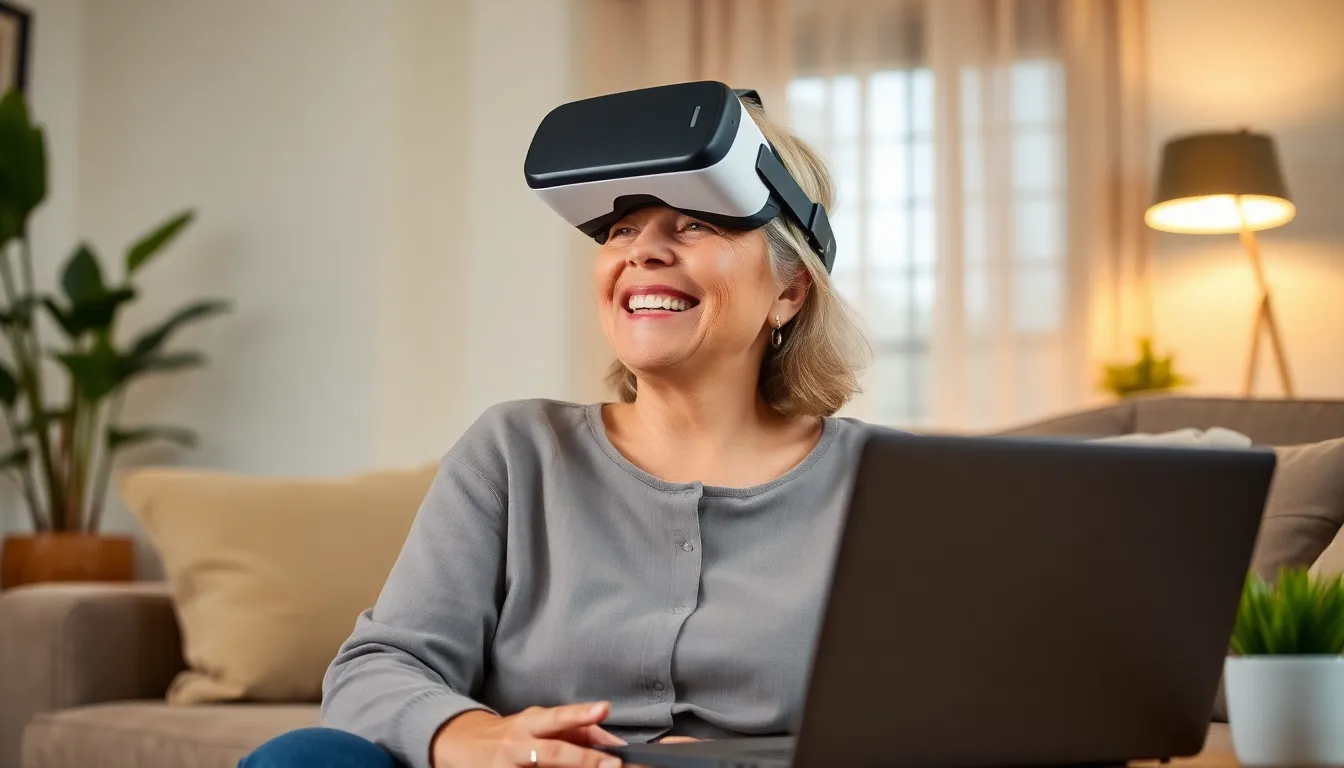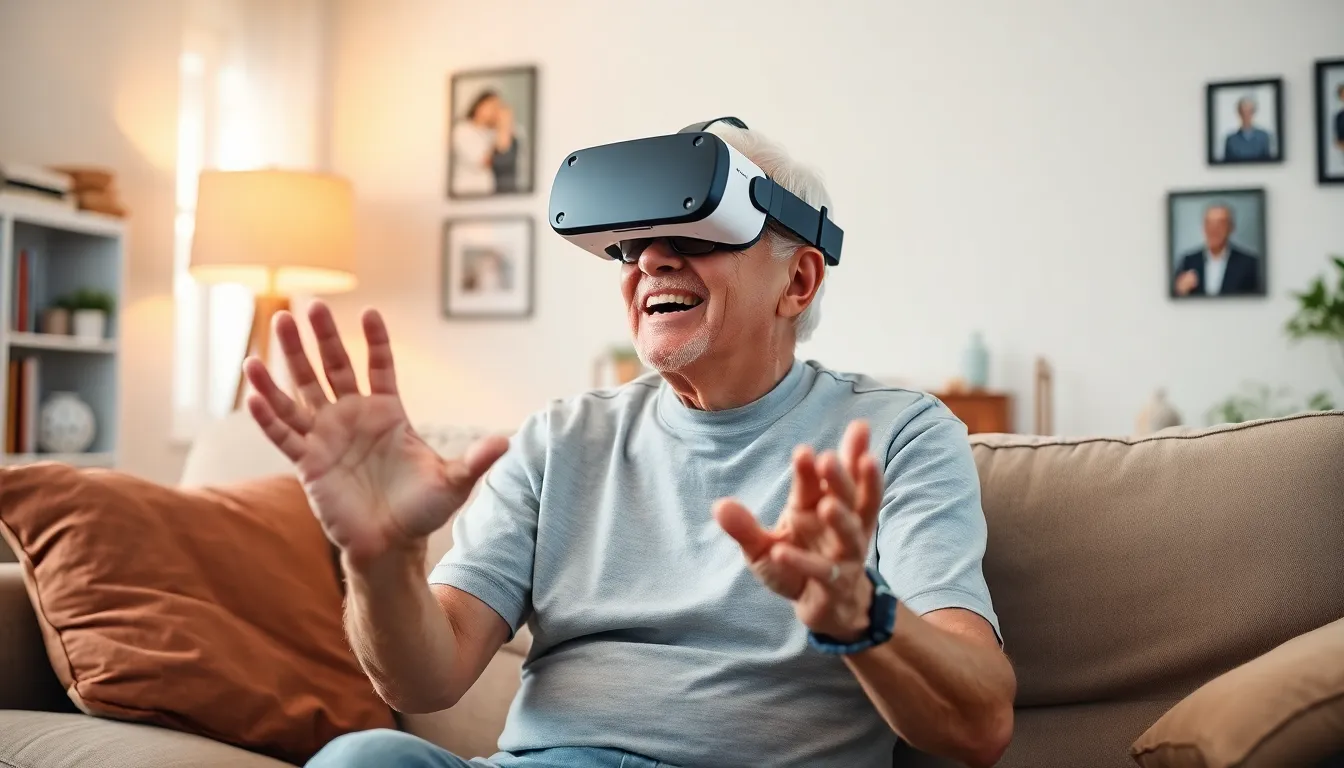Table of Contents
ToggleImagine stepping into a world where the only limit is your imagination. For seniors, virtual reality isn’t just a tech fad; it’s a gateway to adventure, connection, and a sprinkle of fun. Gone are the days of sitting on the porch reminiscing about the good old days. Now, they can explore the Great Wall of China or dance with dolphins—all from the comfort of their living rooms.
Virtual reality offers more than just entertainment. It enhances cognitive skills, boosts social interaction, and even combats loneliness. As technology evolves, seniors can embrace this digital playground, proving that age is just a number and adventure has no expiration date. So grab those VR goggles and get ready for a wild ride—because who says you can’t teach an old dog new tricks?
Understanding Virtual Reality
Virtual reality (VR) immerses users in a computer-generated environment. This technology uses headsets and sensors to create an interactive experience. Seniors benefit significantly from this innovation, as it offers engagement and stimulation through various programs.
Cognitive engagement increases when seniors navigate VR experiences. Activities range from virtual travel to interactive games. Exploration of new places, such as the Great Wall of China or underwater ecosystems, becomes accessible.
Social interaction enhances through VR platforms. Users can connect with family or friends in a shared virtual space. Communication tools within these environments foster meaningful relationships.
Physical benefits emerge as seniors participate in VR exercises. motor skills develop during activities like dancing or playing sports. Regular participation can lead to improved balance and coordination.
Emotional well-being sees positive changes as loneliness decreases. VR combats feelings of isolation by providing opportunities for connection. Enjoyable experiences uplift spirits and encourage happier moods.
Accessibility remains crucial for senior users. Devices designed for ease of use accommodate those with mobility or vision limitations. Simplified controls and user-friendly interfaces ensure everyone can join in.
Overall, the impact of virtual reality is profound. Empowering seniors to explore, connect, and enhance their quality of life is a significant achievement. This technology stands as a promising tool for improving physical, cognitive, and social health.
Benefits of Virtual Reality for Seniors

Virtual reality offers significant advantages for seniors, enhancing their lives in various ways. Two primary benefits include cognitive enhancement and a reduction in feelings of isolation.
Enhancing Cognitive Function
Engaging in virtual reality experiences stimulates mental processes. Seniors encounter puzzles and challenges that demand critical thinking. Participating in interactive games improves memory retention. Exploring new environments through VR promotes spatial awareness. Regularly using VR contributes to better cognitive health. Overall, the mental stimulation provided by these immersive experiences can help maintain sharpness as seniors age.
Reducing Feelings of Isolation
Virtual reality serves as a powerful tool to combat loneliness among seniors. Connecting with family and friends through shared VR experiences fosters meaningful interactions. Joining virtual groups or classes brings a sense of community. Engaging in immersive experiences allows for socialization without physical barriers. As seniors enjoy these adventures, their spirits rise, enhancing emotional well-being. Through VR, individuals can explore new worlds while strengthening interpersonal bonds, significantly reducing feelings of isolation.
Popular Virtual Reality Experiences for Seniors
Numerous virtual reality experiences cater specifically to seniors, enhancing engagement and enjoyment. The following sections highlight some of the most popular options.
Virtual Travel Adventures
Virtual travel adventures enable seniors to explore iconic global locations without leaving home. Seniors can immerse themselves in the breathtaking views of the Grand Canyon or take a leisurely stroll through the streets of Paris. These experiences not only offer visual stimulation but also provide educational insights about diverse cultures and histories. Research shows that virtual travel reduces stress and improves overall mental well-being. Connecting with these new environments sparks curiosity and joy, making it a favored choice for many older adults.
Interactive Games and Exercises
Interactive games and exercises offer seniors an engaging way to stay active. Many platforms provide fun activities, like bowling or aerobics, specifically designed for accessible participation. These games promote physical movement while also enhancing hand-eye coordination and balance. Participation leads to improvements in both physical and cognitive health. Engaging in social-friendly games encourages interaction among peers, reducing feelings of isolation. Reports indicate that seniors who regularly play virtual games exhibit heightened mood levels and increased enthusiasm for activity.
Considerations for seniors Using Virtual Reality
Engaging seniors in virtual reality requires thoughtful considerations that prioritize their safety and comfort. Ensuring the right environment and equipment enhances the experience.
Safety Measures and Comfort
Safety plays a vital role in VR experiences. Establishing a clutter-free space minimizes the risk of accidents while using VR headsets. Adjusting the headset for proper fit enhances comfort and reduces strain. It’s essential to monitor posture during sessions to prevent discomfort or fatigue. Taking frequent breaks helps alleviate symptoms like dizziness or nausea, particularly for newcomers to VR. Staying hydrated before and during sessions promotes overall well-being, ensuring seniors enjoy their VR adventures without issues.
Choosing the Right Equipment
Selecting suitable equipment is crucial for optimizing VR experiences for seniors. Lightweight headsets reduce strain on the neck and enhance user comfort. Devices with adjustable settings allow customization to accommodate various vision and mobility needs. It’s important to explore options with clear user interfaces, allowing seniors to navigate easily. Additionally, motion controllers should be intuitive, fostering engagement without overwhelming users. Many devices offer access to a range of experiences tailored toward older adults, promoting enjoyable interactions and connections.
Virtual reality offers seniors an exciting way to engage with the world around them. By breaking down barriers to adventure and connection, VR opens doors to experiences that enrich their lives. It not only stimulates cognitive function but also fosters social bonds, making it a valuable tool for enhancing overall well-being.
As technology continues to evolve, the accessibility and variety of VR experiences tailored for seniors will likely expand. Embracing these innovations can lead to a more fulfilling and active lifestyle, proving that age is just a number when it comes to exploration and enjoyment.




